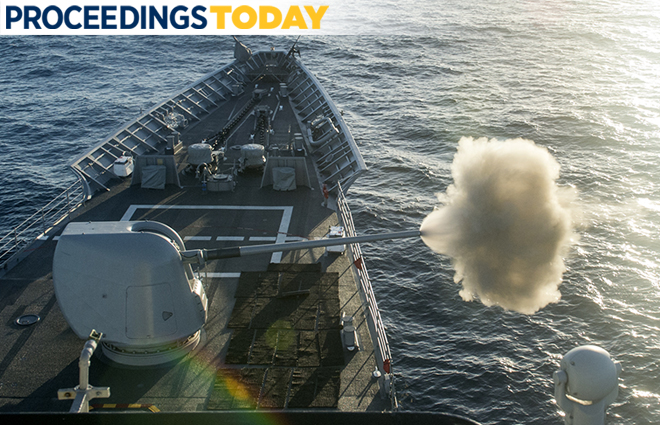
The naval gun is a compact, easily supported, proven weapon. Just as war on land will always require rifles and boots on the ground, war in the littorals will always require heavily armed ships in the area of conflict inflicting violence on the enemy on land and at sea. The most cost-effective and reliable way to arm ships is the gun.
Julian Corbett wrote in his 1911 book, Some Principles of Maritime Strategy, that sea power is nothing if it cannot bring about desired changes and effects ashore, because it is only when an enemy is affected on land that a nation can achieve the political ends it desires. The ability to project force ashore is crucial. From War of 1812 gunboats, to Civil War ironclads, to World War II patrol boats, to the Vietnam war riverine units, to today’s patrol coastal ships, the U.S. Navy has a long history of using guns to fight and win in the littorals.
Any tool used to project lethality ashore must not only bring maximum violence to bear but also must offer the most bang for the buck. A Tomahawk land attack missile costs around $1 million. An AGM-84 Harpoon costs $1.2 million. By contrast, a single Mk 45 127-mm/5-inch shell costs a few hundred dollars, showing that only naval guns can provide the volume of fire necessary at a manageable price point. (Even advanced projectiles such the Army’s M982 Excalibur cost a fraction of the price of a missile—less than $70,000 per round for the Excalibur.)
Guns obviously have much shorter range than missiles, though sabot-loaded submunitions improve their range over conventional projectiles. In 2002, Germany experimented with placing the turret of a PzH 2000 155-mm artillery piece on a Sachsen-class frigate. This produced an effective range of more than 16 nautical miles (nm). In 1967, the U.S. Navy also began development of a long-range projectile for the Mk7/50 16-inch guns on Iowa-class battleships, using leftover nonnuclear shells from the Army’s nuclear cannon program. The Navy created sabot rounds with a range of more than 40 nm, compared to around 20 for conventional rounds—using technology from the 1930s.
That older technology is resilient. Although driven by electronics, the gun is fundamentally a mechanical system. If need be, a sailor can override malfunctioning computers and manually input elevation and windage orders. Pneumatics and hydraulics are comparatively easy to maintain and repair, rarely requiring depot-level troubleshooting from contractor technicians working on shore to fix software bugs or run through miles of cable to find one bad wire, as often is the case with missile and electronic system faults. A few machinists and gunner’s mates can patch piping and hoses and in many cases quickly return a damaged gun to working order. The gun is at its heart an analog weapon—hearty and reliable.
Because sailors can bypass most gun electronics, guns are not particularly vulnerable to electronic warfare jamming. Opposing forces’ electronic countermeasures can jam radar and spoof GPS, but even in a heavily contested electromagnetic environment, sailors can still fire guns. In a visual-range engagement, or with a forward observer in place to provide corrections in beyond-visual-range encounters, the ship can still hit its target. The Marine Corps fields air-naval gunfire liaison companies, units specially trained to call in naval gunfire, for just this purpose. Navy riverine and coastal patrol craft are capable of closing with the shore to provide forward observation.
Today’s Navy has all the pieces in place to provide fire support at sea or ashore—but not the practice or the right weapon. With some high-frequency radios, a good team of forward observers, and a calculator, you can provide danger-close fire support. In its quest to produce ever-more-lethal missiles, or high-technology guns such as the Zumwalt-class ships’ advanced gun system (with its now-cancelled projectile that had an estimated unit cost of nearly $700,000), the Navy has lost sight of the basics and utility of naval gunnery. It is time for the service to return its focus to a capability that has proven effective in combat time after time.
Lieutenant Miller is a surface warfare officer, currently stationed within the Future Operations Directorate of U.S. Sixth Fleet in Naples, Italy. He has previously served as the ASW Officer on board USS Simpson (FFG-56) and as the weapons and executive officer on board USS Zephyr (PC-8).
For more great Proceedings content, click here.


